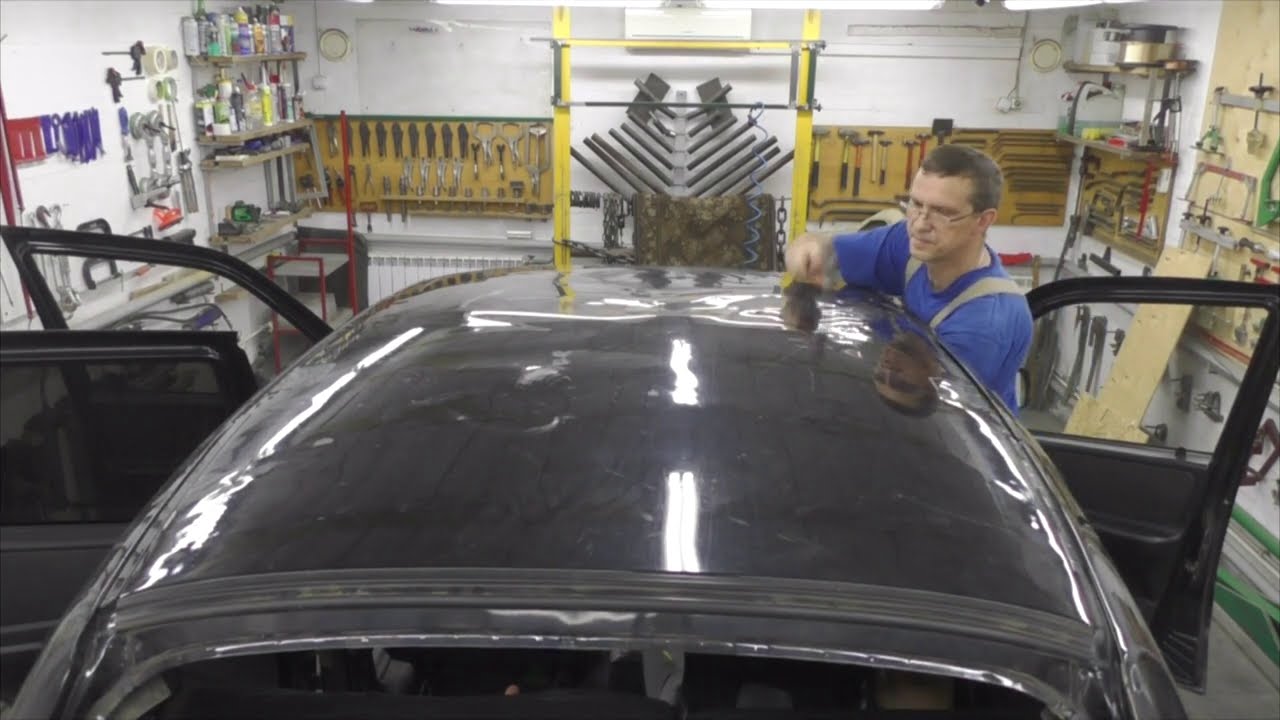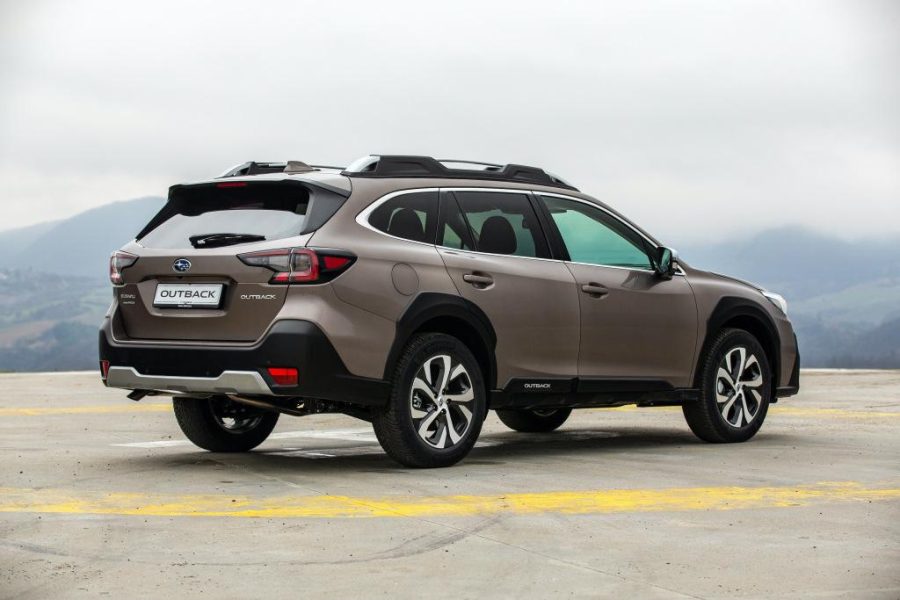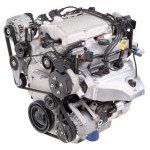
Construction of cars for driving schools
 The main parts of the four-stroke gasoline engine
The main parts of the four-stroke gasoline engine
- Fixed parts: cylinder head, cylinder block, crankcase, cylinders, oil pan.
- Moving parts: 1. crank mechanism: crankshaft, connecting rod, piston, piston rings, piston pin, seger fuses. 2nd timing mechanism: camshaft, pushers, valve stems, rocker arms, valves, return springs.
Four-stroke positive ignition engine operation
- 1st time: suction: the piston moves from top dead center (DHW) to bottom dead center (DHW), the intake valve of the combustion chamber is the intake mixture of fuel and air.
- 2 period: compression: the piston returns from the DHW to the DHW and the suction mixture is compressed. The inlet and outlet valves are closed.
- 3rd time: explosion: the compressed mixture is ignited by a high-voltage spark from the spark plug, an explosion occurs and at the same time, engine power is generated, when the piston is pushed with great force from DH to DHW, the crankshaft rotates under pressure in the cylinder.
- 4th time: exhaust: the piston returns from DH to DH, the exhaust valve is open, the combustion products are forced into the air through the exhaust pipe.
Difference between four-stroke and two-stroke engine
- four-stroke engine: four strokes of the piston are made, all hours of work are performed on the piston, the crankshaft makes two revolutions, has a valve mechanism, lubrication is pressure.
- two-stroke engine: two hours of work are done at the same time, the first is suction and compression, the second is explosion and exhaust, the hours of work are done above and below the piston, the crankshaft completes one revolution, has a distribution channel, lubrication is its own oil mixture, gasoline and air .
OHV distribution
The camshaft is located in the engine block. The valves (inlet and outlet) are controlled by lifters, valve stems and rocker arms. The valves are closed by return springs. The camshaft drive is a chain link. For each type of valve timing, the crankshaft rotates 2 times and the camshaft rotates 1 time.
OHC distribution
Structurally, it is simpler. The camshaft is located in the cylinder head and its cams directly control the rocker arms. Unlike the OHV distribution, there are no lifters and valve stems. The drive is made from the crankshaft by means of a link chain or a toothed belt.
Divorce 2 OHC
It has two camshafts located in the cylinder head, one of which controls the intake and the other exhaust valves. The drive is the same as for the OHC dispensing.
Axle types
front, rear, middle (if applicable), driven, driven (engine power transmission), steered, uncontrolled.
Battery ignition
Purpose: to ignite the compressed mixture at the right time.
Main parts: battery, junction box, induction coil, distributor, circuit breaker, capacitor, high voltage cables, spark plugs.
Operation: after turning the key in the junction box and disconnecting the voltage (12 V) at the switch, this voltage is applied to the primary winding of the induction coil. A high voltage (up to 20 V) is induced on the secondary winding, which is distributed between the individual spark plugs in the order 000-1-3-4 by means of the divider arm in the divider along high-voltage cables. The capacitor serves to prevent burnout of the switch contacts and removes excess energy.
battery
It is a constant source of electricity in your car.
Main parts: packaging, positive (+) and negative (-) cells, lead plates, spacers, positive and negative battery terminal. The cells are immersed in an electrolyte in a bag (a mixture of sulfuric acid with distilled water to a density of 28 to 32 Be).
Maintenance: topping up with distilled water, cleanliness and tightening the positive and negative contact.
Induction coil
It is used to induce (convert) a 12 V current into a high voltage current up to 20 V. It consists of a case, primary and secondary windings, an iron core and a potting compound.
Manifold
It is used to distribute high voltage to individual spark plugs at the right time to keep the engine running regularly and smoothly. The distributor is driven by a camshaft. The distributor shaft ends with cams that control the movable lever (contact) of the switch, with which the 12 V voltage is interrupted, and at the moment of interruption a high voltage is induced in the induction coil, which is carried through the cable to the distributor. Here the voltage is distributed to the candles. A part of the distributor is a capacitor, which serves to prevent burning of the switch contacts. The other part is the vacuum centrifugal regulator. Depending on the suction pressure in the intake manifold and the engine speed, they regulate the ignition timing when the engine speed increases.
Electrical appliances in the car
starter (largest instrument), headlights, warning and warning lamps, horn, windshield wipers, portable lamp, radio, etc.
Starter
Purpose: to start the engine.
Details: stator, rotor, stator winding, commutator, electromagnetic coil, gear, gear fork.
Principle of operation: when voltage is applied to the coil winding, the core of the electromagnet is drawn into the coil. The pinion is inserted into the flywheel toothed ring using the pinion yoke. This closes the rotor contact, which spins the starter.
Generator
Purpose: a source of electrical energy in a vehicle. As long as the engine is running, it supplies energy to all electrical appliances in use and charges the battery at the same time. Driven from the crankshaft using a V-belt. It produces alternating current, which is rectified to constant voltage by rectifier diodes.
Parts: stator with winding, rotor with winding, rectifier diodes, battery, carbon catcher, fan.
dynamo
Use as an alternator. The difference is that it gives out constant current, it has less power.
Electric candles
Purpose: to ignite the sucked-in and compressed mixture.
Parts: positive and negative electrode, ceramic insulator, thread.
Designation example: N 14-7 - N normal thread, 14 thread diameter, 7 glow plugs.
Cooling types
Purpose: removal of excess heat from the engine and ensuring its operating temperature.
- liquid: serves to remove heat, which is created due to the friction of the rubbing parts of the engine and heat removal during thermal time (explosion). For this, distilled water is used, and in winter - antifreeze. It is prepared by mixing distilled water with antifreeze coolant (Fridex, Alycol, Nemrazol). The ratio of the components depends on the desired freezing point (eg -25°C).
- air: 1. draft, 2. forced: a) vacuum, b) overpressure.
Cooling system parts: radiator, water pump. water jacket, thermostat, temperature sensor, thermometer, hoses and pipes, drain hole.
Operation: after turning the engine, the water pump (driven by the crankshaft through the V-belt) operates, the task of which is to circulate the fluid. This fluid circulates when the engine is cold only in the separate engine block and cylinder head. When heated to around 80°C, the thermostat opens the flow of liquid through a valve to the cooler, from which a water pump pumps out the cooled liquid. This pushes the heated fluid out of the cylinder block and into the radiator. The thermostat is designed to maintain a constant operating temperature of the coolant (80-90°C).
Смазка
Purpose: lubricate moving parts and friction surfaces, cool, seal, wash away dirt and protect moving parts from corrosion.
- Pressure lubrication: performed by engine oil. The oil sump houses a gear pump that draws oil through a suction basket and presses against moving parts (crank-timing mechanism) through lubrication channels. Behind the gear pump is a relief valve that protects the lubrication kit from high pressure in thick, cold oil. The oil is forced through an oil cleaner (filter) that traps dirt. Another detail is an oil pressure sensor with an alarm on the instrument panel. The oil used for lubrication is returned to the oil pan. Engine oil gradually loses its lubricating properties, so it must be changed after a run of 15 to 30 thousand km (prescribed by the manufacturer). Replacement is done after driving, while the engine is still warm. At the same time, you need to replace the oil cleaner.
- Grease: Used in two-stroke engines. We must add to the gasoline engine oil that is designed for two-stroke gasoline engines, in the ratio indicated by the manufacturer (for example, 1:33, 1:45, 1:50).
- Spray lubrication: Oil is sprayed onto moving parts.
Vehicle drive system
Details: engine, clutch, gearbox, propeller shaft, gearbox, differential, axles, wheels. Power is transmitted through the named parts and the vehicle is propelled. If the engine, clutch, transmission and differential are connected together, there is no PTO shaft.
communication
Purpose: used to transfer engine power from the engine to the gearbox and for short-term shutdown, as well as for soft start.
Details: clutch pedal, clutch cylinder, single lever, release bearing, release levers, compression springs, pressure plate with lining, clutch shield. The clutch pressure plate is located in the flywheel, which is rigidly connected to the crankshaft. Disengage and engage the clutch with the clutch pedal.
Transmission of infection
Purpose: serves for optimal use of engine power. By changing gears, the vehicle can move at different speeds at a constant engine speed, overcoming rough terrain when driving, moving forward, backward and at idle.
Details: gearbox, drive, driven and intermediate shafts, gears, reverse gear, sliding forks, control lever, transmission oil filling.
Transmission
Purpose: to distribute the power of the motor to the wheels of the driving axle.
Details: gearbox, gear, disc wheel.
Refueling: transmission oil.
Differential
Purpose: Used to split the speed of the left and right wheels when cornering. It is always only on the drive axle.
Types: tapered (passenger cars), front (some trucks)
Parts: differential housing = differential cage, satellite and planetary gear.
Fuel system of a gasoline engine
Purpose: to supply fuel to the carburetor.
Details: tank, fuel cleaner, diaphragm transport fuel pump, carburetor.
The fuel pump is driven by a camshaft. Moving the pump from top to bottom, gasoline is sucked from the tank and, moving it up, pushes the fuel into the carburetor's float chamber. The fuel tank is equipped with a float that detects the level of fuel in the tank.
- Forced transportation (tank lowered, carburetor up).
- By gravity (tank up, carburetor down motorcycle).
Carburetor
Purpose: used to prepare an air-gasoline mixture in a ratio of 1:16 (gasoline 1, air 16).
Details: float chamber, float, float needle, mixing chamber, diffuser, main nozzle, idle nozzle, accelerator bomb ****, throttle valve, throttle.
Sytic
This is part of the carburetor. It is used to enrich the mixture when starting the engine in a cold state. The throttle is operated by a lever or automatically if it is equipped with a bimetallic spring, which automatically opens it after cooling.
Accelerator pump ****
This is part of the carburetor. The accelerator bomb **** is connected to the accelerator pedal. It is used to immediately enrich the mixture when the accelerator pedal is depressed.
Management
Goal: move the car in the right direction.
Details: steering wheel, steering column, steering gear, main steering arm, steering rod, power steering lever, ball joints.
- crest
- screw
- screw
brakes
Purpose: to slow down and safely stop the car, to protect it from self-movement.
By appointment:
- worker (affects all wheels)
- parking (only on wheels of the rear axle)
- emergency (parking brake is used)
- terrain (trucks only)
On control on wheels:
- jaw (drum)
- disk
Hydraulic brake
Used as a service brake, it is a dual circuit foot brake.
Details: brake pedal, master cylinder, brake fluid reservoir, pipelines, wheel brake cylinders, brake pads with linings, brake drum (for rear wheels), brake disc (for front wheels), brake shield.
Mechanical brake
Used as a parking brake, manually operated, acts only on the rear axle wheels, acts as an emergency brake.
Details: handbrake lever, safety rod, cable cars with steel cables, brake shoe tensioner.
Air purifiers
Purpose: used to clean the intake air into the carburetor.
- Dry: paper, felt.
- Wet: the package contains oil that traps dirt, and the cleaned air enters the carburetor. Dirty cleaning agents must be cleaned and replaced later.
Suspense
Purpose: provides constant contact of the wheel with the road and flexibly transfers the unevenness of the road to the body.
- Coil springs.
- Springs.
- Torsions.
Shock absorbers
Purpose: to dampen the effect of the spring, to ensure the stability of the car when cornering.
- Telescopic.
- Lever (single or double acting).
Stop
Purpose: to prevent damage to the suspension and shock absorbers. They are made of rubber.

